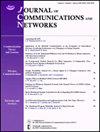Transformer-enabled hybrid precoding for TDD large-scale antenna arrays systems with channel sensing
IF 3.2
3区 计算机科学
Q2 COMPUTER SCIENCE, INFORMATION SYSTEMS
引用次数: 0
Abstract
Hybrid precoding is a crucial technique for massive multiple-input multiple-output (MIMO) systems owing to its capability to offer an adequate beamforming gain while reducing the hardware cost. However, the nonconvex objective functions and constraints pose great challenges to hybrid precoders design. The conventional precoding method that contains a two-step process including channel estimation and precoding design based on such estimate is not necessarily optimal to tackle this problem. In this article, a transformer-empowered approach waiving high-dimensional channel estimation is proposed to design precoders with the goal of simplifying the complicated hybrid precoding problem into the optimization of neural network structure. Specifically, the proposed approach learns channel sensing from uplink pilots and then operates downlink hybrid precoding depended on interleaved-polymerization-transformer-based analog precoding network (IPTAP-Net) which decomposes on a peruser basis and conventional linear digital precoding algorithm to reduce computational complexity in multi-user systems. Simulations show that the proposed methodology acquires remarkable performance improvement and strong robustness, as compared to state-of-the-art hybrid precoding schemes. Furthermore, proposed approach develops a generalizable talent for manifold multi-user cells.具有通道传感的TDD大规模天线阵列系统的变压器混合预编码
混合预编码是大规模多输入多输出(MIMO)系统的一项关键技术,因为它能够在降低硬件成本的同时提供足够的波束形成增益。然而,非凸目标函数和约束给混合预编码器的设计带来了很大的挑战。传统的预编码方法包含信道估计和基于信道估计的预编码设计两步过程,并不一定是解决这一问题的最佳方法。本文提出了一种基于变压器的免高维信道估计预编码器设计方法,旨在将复杂的混合预编码问题简化为神经网络结构的优化。具体而言,该方法从上行导频中学习信道感知,然后基于基于交叉聚合变压器的模拟预编码网络(IPTAP-Net)和传统的线性数字预编码算法进行下行混合预编码,以降低多用户系统的计算复杂度。仿真结果表明,与目前最先进的混合预编码方案相比,该方法具有显著的性能改进和较强的鲁棒性。此外,该方法还开发了一种适用于多种多用户单元的泛化能力。
本文章由计算机程序翻译,如有差异,请以英文原文为准。
求助全文
约1分钟内获得全文
求助全文
来源期刊
CiteScore
6.60
自引率
5.60%
发文量
66
审稿时长
14.4 months
期刊介绍:
The JOURNAL OF COMMUNICATIONS AND NETWORKS is published six times per year, and is committed to publishing high-quality papers that advance the state-of-the-art and practical applications of communications and information networks. Theoretical research contributions presenting new techniques, concepts, or analyses, applied contributions reporting on experiences and experiments, and tutorial expositions of permanent reference value are welcome. The subjects covered by this journal include all topics in communication theory and techniques, communication systems, and information networks. COMMUNICATION THEORY AND SYSTEMS WIRELESS COMMUNICATIONS NETWORKS AND SERVICES.

 求助内容:
求助内容: 应助结果提醒方式:
应助结果提醒方式:


